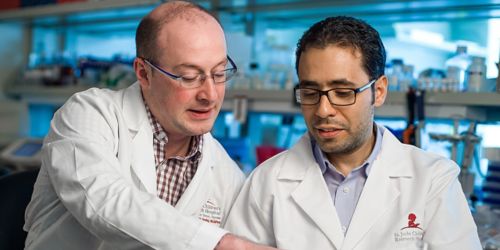St. Jude Family of Websites
Explore our cutting edge research, world-class patient care, career opportunities and more.
St. Jude Children's Research Hospital Home

- Fundraising
St. Jude Family of Websites
Explore our cutting edge research, world-class patient care, career opportunities and more.
St. Jude Children's Research Hospital Home

- Fundraising
Cells trained to recognize returning infections

Ben Youngblood, PhD, pictured with Hazem Ghoneim, PhD, both of Immunology, and colleagues showed how memory CD8 T cells arise from a small subset of effector CD8 T cells in laboratory models.
How our lab found out Memory T cells are made, not born
How are memory T cells formed?
The answer could help researchers design more effective vaccines and expand cancer immunotherapies.
Our lab conducted experiments to help resolve this question, and what we found has established a path to further investigate how to effectively support them in a body’s efforts to rid itself of pathogens. We worked specifically with CD8 T cells, a powerful part of our body’s immune system. These cells eradicate intracellular infections, and through vaccination, manufacture immunity to chronic illness and cancer.
What are T cells
Let’s first define the types of CD8 T cells we’re working with —naïve, memory and effector.
- Naïve T cells, formed in the thymus, are cells that haven’t yet encountered the pathogen they’re destined to fight. Their importance lies in continual surveillance for unfamiliar pathogens in the body.
- Effector T cells, aka cytotoxic (killer) T cells, are the ones that combat pathogens — viral infections, cancer and other threats. These cells are terminally differentiated, which means they fight to the death.
- Memory T cells are ones throughout the body ready to recognize and respond if a pathogen reappears.
The question
The science community had differing theories about the formation of CD8 memory T cells.
One possibility was that T cells are born that way, descending directly from new, or naïve, T cells. Another possibility was that the cells arose from a set of effector T cells that dedifferentiate, meaning the memory T cells are formed by killer T cells that reverse, or lose, some of their specialized characteristics.
Our research, published in Nature, provides compelling evidence that memory CD8 T cells arise from effector CD8 T cells.
What we did
In our research with preclinical mouse models for examining T cell responses to acute viral infection, and a concurrent Emory University study in humans, we found evidence supporting memory T cells arising from a small subset of effector T cells. Our analysis went deep into gene expression and whole-genome sequencing, and we saw that memory CD8 T cells retained aspects of their former life as effector cells. Concurrently, the Emory University study showed that memory T cells were formed from replicating effector T cells.
We believe that, more than likely, the memory T cells originate from effector T cells that survive an immune response. In other words, these cells weren’t terminally differentiated — but they weren’t at the front line of the battle either. They were a little behind the front line, waiting to see what happened.
What occurs in those T cells to make that happen? That’s a big question. Our initial thought is that it’s related to epigenetic mechanisms. In other words, the transformational mechanism is caused by something other than the T cell’s genetic code. It’s made, not born.
Clinically, you see where this goes, right?
You want to establish a long-lived memory T cell response, say, in vaccination for either chronic infections or a tumor. It’s very important to understand how you generate those cells and where they derive from. Having a battalion of memory T cells trained to fight would go a considerable way toward treating many forms of cancer and other viral infections.
Our lab continues this research to determine the mechanisms that engender memory T cells with long-lived effector programs. Once we understand those mechanisms, we may be able to take the cells that have gone down the wrong path in cancer patients and take them back to a stage where they can reengage and fight.






